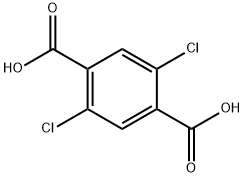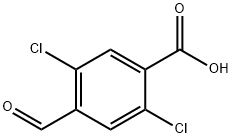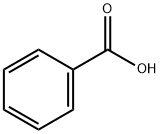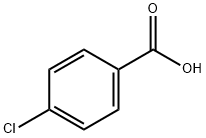
2,5-DICHLOROTEREPHTHALIC ACID synthesis
- Product Name:2,5-DICHLOROTEREPHTHALIC ACID
- CAS Number:13799-90-1
- Molecular formula:C8H4Cl2O4
- Molecular Weight:235.02

1124-05-6

13799-90-1
General procedure for the synthesis of 2,5-dichloroterephthalic acid from 2,5-dichloro-p-xylene: 5 g (0.028 mol) of 2,5-dichloroterephthalic acid, 26 g (0.165 mol) of potassium permanganate, 80 mL of pyridine, and 20 mL of deionized water were added to a 250 mL round-bottom flask. The reaction mixture was heated to 100 °C and stirred for 12 hours. The brown manganese oxide was removed by filtration while hot and the brown solid was subsequently re-slurried twice with 100 mL of deionized water. The filtrates were combined and the solvent was removed by distillation under reduced pressure. The resulting pale yellow syrupy liquid was acidified with hydrochloric acid to pH=1. The white solid was collected by filtration through a glass sand-core funnel and dried in a vacuum oven at 50°C overnight. Yield: 53-87%. General procedure for the synthesis of 2,5-di-(p-toluic acid)-terephthalic acid: a three-necked round-bottomed flask equipped with an argon inlet and a magnetic stirrer was charged with 23.19 g (0.216 mol) of p-toluidine, 3.6 g (0.014 mol) of 2,5-dichloroterephthalic acid, 4.6 g (0.033 mol) of anhydrous K2CO3, 0.060 g ( 0.00033 mol) anhydrous copper(II) acetate, 0.750 g (0.0045 mol) potassium iodide, 16.8 g (0.271 mol) ethylene glycol and 3.8 g (0.211 mol) deionized water. The mixture was heated to 130 °C and maintained for 12 hours under argon protection. After the reaction was completed, it was cooled to room temperature and diluted with 50 mL of deionized water. Hydrochloric acid was added with stirring to adjust the pH to 1. A dark colored solid was obtained by filtration through a glass sand core funnel. The solid was dissolved in a pH 7 solution containing 3 mL of ammonium hydroxide and 250 mL of deionized water and filtered to remove undissolved solid. The resulting yellow-green solution was acidified with acetic acid to pH=3. After acidification, a dark brown solid was formed, filtered through a glass sand-core funnel, and dried in a vacuum oven at 100°C overnight. Yield: 31%. General procedure for the synthesis of quinacridone PR122 nanoparticles: 15 g of polyphosphoric acid and 1 g of 2,5-di-(p-tolylamino)-terephthalic acid powder were added to a 250 mL round-bottomed flask fitted with a magnetic stirring bar. The mixture was heated to 160 °C and maintained for 2 h. A deep purple-red color appeared during the reaction. After completion of the reaction, it was cooled to room temperature and diluted with 80 mL of concentrated sulfuric acid. The resulting solution was transferred to a dropping funnel and slowly added dropwise under stirring to a resin kettle containing 100 mL of N-methyl-2-pyrrolidone and 1.96 g (0.002 mol) of SPAN 85, and the temperature was controlled to be below 45 °C during the dropwise addition. After dropwise addition, stirring was continued at room temperature for 30 min, followed by filtration through a glass sand core funnel. The resulting solid was re-slurried sequentially with 300 mL of isopropanol and 300 mL of deionized water, each time filtered through a glass sand core funnel. Finally, the product was freeze-dried for 48 hours. Yield: 50% (D50 = 100 ± 1.4 nm, GSD = 1.71 ± 0.04). Transmission electron microscopy observations showed that the particle morphology was that of thin circular flakes of regular shape with a size range of about 50 to 100 nm.

1124-05-6
193 suppliers
$6.00/5g

13799-90-1
162 suppliers
$5.00/250mg
Yield:13799-90-1 53%
Reaction Conditions:
Stage #1: 1,4-dichloro-2,5-dimethylbenzenewith pyridine;potassium permanganate in water at 100; for 12 h;
Stage #2: with hydrogenchloride in water; pH=1;
Steps:
4
Example 4Preparation of Nanopigment Red 122 (Method of Making II)Synthesis of dichloro terephthalic acid; In a 250 mL round bottom flask were introduced 5 g (0.028 mol) 2,5-dichloro-p-xylene, 26 g (0.165 mol) potassium permanganate, 80 mL pyridine and 20 mL deionized water. The mixture was heated to 100° C. with stirring for 12 hours. The brown manganese oxide was filtered while the suspension was still hot, and the brown solid reslurried twice with 100 mL deionized water. The liquids were combined and the solvents removed in vacuum. The yellowish syrupy liquid obtained was acidified with hydrochloric acid to a pH of 1. The white solid was filtered using a glass frit and dried in a vacuum oven at 50° C. overnight. Yield: 53-87%.Synthesis of 2,5-di-(p-toluidino)-terephthalic acids; In a 3 neck round bottom flask fitted with Argon inlet and magnetic stirring were charged; p-toluidine 23.19 g (0.216 mol), 2,5-dichloro-terephthalic acid 3.6 g (0.014 mol), anhydrous K2CO34.6 g (0.033 mol), anhydrous Copper (II) acetate 0.060 g (0.00033 mol), potassium iodide 0.750 g (0.0045 mol), ethylene glycol 16.8 g (0.271 mol) and deionized water 3.8 g (0.211 mol). The mixture was heated to 130° C. for 12 hours under argon. The reaction mixture was cooled to room temperature and diluted with 50 mL deionized water. Hydrochloric acid was added with stirring up to a pH of 1. The resultant dark solid is filtered using a glass frit. The solid was then dissolved into a solution of pH 7 containing ammonium hydroxide (3 mL) and deionized water (250 mL). The undissolved solid was filtered. The resultant yellow-green solution was acidified with acetic acid up to a pH of 3÷4. Upon acidification a dark brown solid formed. The solid was filtered using a glass frit and dried in a vacuum oven at 100° C. overnight. The resultant yield was 31%.Synthesis of the quinacridone PR122 nano; In a 250 mL round bottom flask fitted with a magnetic stirring bar were charged: 15 g polyphosphoric acid, 1 g powder of 2,5,di-(-toluidino)-terephthalic acids. The mixture was heated at 160° C. for two hours. A dark violet reddish color appeared. The reaction mixture was allowed to cool at room temperature and was diluted with 80 mL concentrated sulfuric acid. The resultant solution was transferred into a dropping funnel. The purple solution was added dropwise with stirring to a resin kettle containing 100 mL N-methyl-2-pyrrolidinone and 1.96 g (0.002 mol) SPAN 85. During the addition, the temperature was maintained below 45° C. When the addition finished, the mixture was stirred at room temperature for 30 minutes and filtered using a glass frit. The resulted solid was reslurried in 300 mL isopropanol, filtered on a glass frit and reslurried in 300 mL deionized water. After filtration on a glass frit the product was freeze dried for 48 hours. The resultant yield was 50%. (D50=100+/-1.4 nm, GSD=1.71+/-0.04) The particle morphology and range in size observed by Transmission Electron Microscopy showed regularly shaped particles consisting of thin, rounded platelets between about 50 and about 100 mm.
References:
US7427323,2008,B1 Location in patent:Page/Page column 21-22

1124-05-6
193 suppliers
$6.00/5g

13799-90-1
162 suppliers
$5.00/250mg

128230-05-7
2 suppliers
inquiry

3293-89-8
25 suppliers
inquiry

13799-90-1
162 suppliers
$5.00/250mg

95-94-3
144 suppliers
$10.00/5g

124-38-9
134 suppliers
$214.00/14L

13799-90-1
162 suppliers
$5.00/250mg

65-85-0
1436 suppliers
$10.00/25g

74-11-3
601 suppliers
$5.00/1g

535-80-8
432 suppliers
$5.00/5g

32888-87-2
10 suppliers
inquiry

13799-90-1
162 suppliers
$5.00/250mg